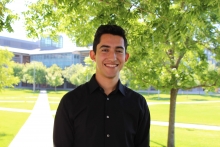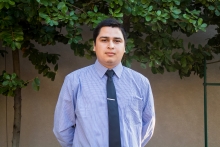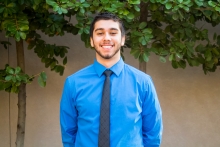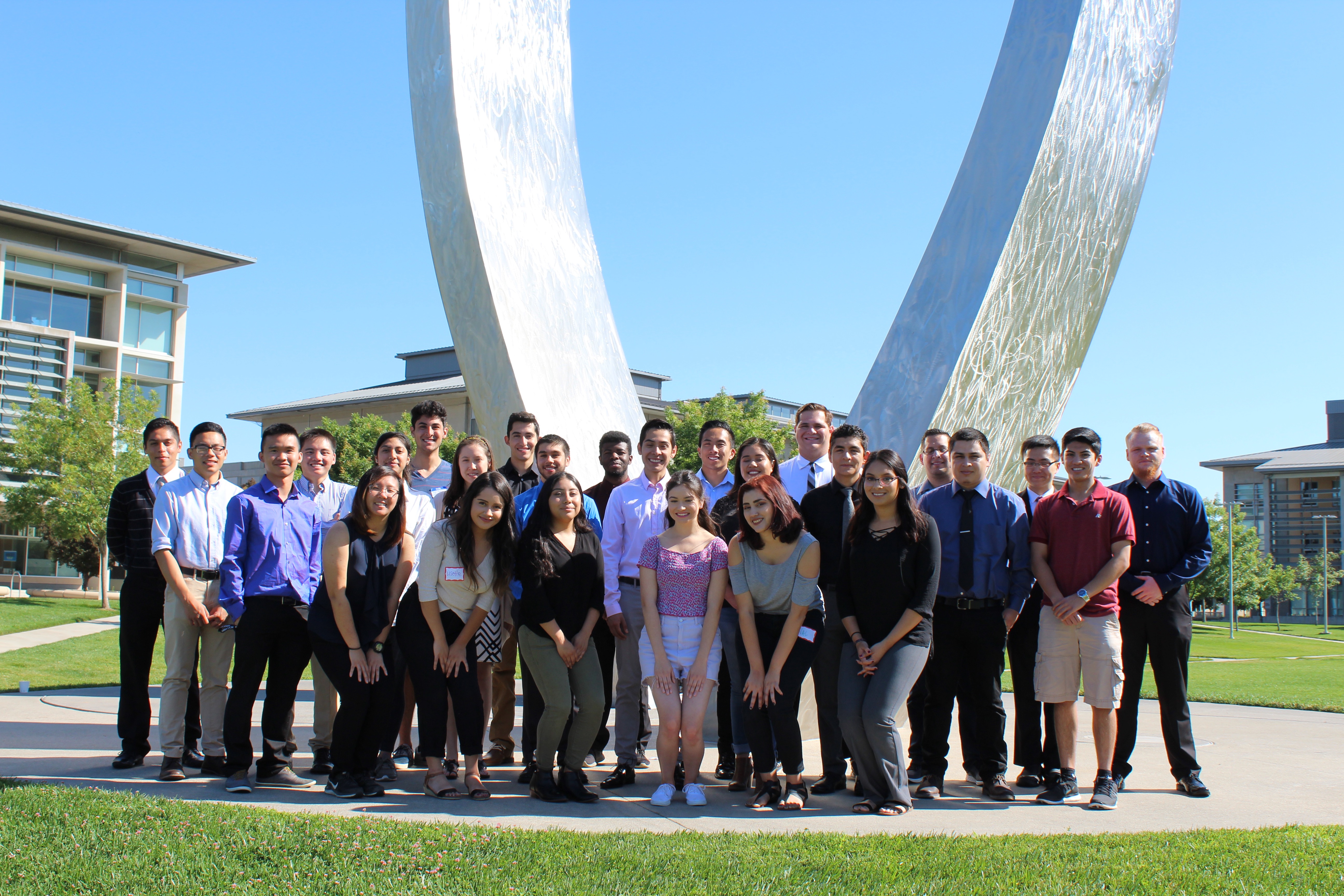Jeffrey Aceves
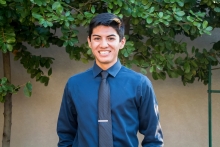 |
Major: Bioengineering
Home City: Bakersfield, CA
Contact: jaceves6@ucmerced.edu
Faculty Mentor: Professor Jennifer Manilay
|
Jeffrey Aceves is a third year undergraduate student from Bakersfield, CA. Expected to graduate in Fall 2018 with a BS in Bioengineering. Jeff's ultimate goal is to attend a graduate school where he may work on completing a Ph.D. in the field of Bioengineering. He has worked in Dr. Jennifer Manilay's research lab since August 2016 and is currently working on developing a mathematical model for the development of LY49 receptors on Natural Killer cells. Before coming to college, Jeff attained the rank of Eagle Scout for which he led the construction of a shade structure for the Kern County Animal Services Shelter. On campus, Jeff works as a Student Supervisor at The Summits Marketplace and is a member of Pi Kappa Phi Fraternity, the Biomedical Engineering Society, and the Catholic Newman Club.
Mathematical Model for the Maturation of Natural Killer Cells
Jeffrey Aceves, Albert Millan, and Jennifer O. Manilay, PhD; School of Natural Sciences, University of California, Merced
Natural Killer (NK) cells are immune system cells with innate ability to eliminate cancerous and virally infected cells. They mature in a linear pathway starting at the double negative (CD27-CD11b-, DN), to the immature (CD27+CD11b-; iNK), then transitional (CD27+CD11b+; tNK), and finally to the most mature (CD27-CD11b; mNK) state. Mathematical models are tools of interest in biological research to predict cell behavior, in conjunction with wet lab experiments. Our objective is to develop a mathematical model that can predict the differentiation of NK cells within a specific time frame and under different conditions. Previous data from our laboratory showed that NK cell maturation is inhibited when Sclerostin domain containing-1 (Sostdc1) protein is absent in mice. We hypothesized that we could use our own biological data to create a mathematical model that predicts NK cell differentiation in Sostdc1-knockout (KO) mice. To test this, we purified iNK and tNK populations from WT and KO spleens and stimulated them with PMA and ionomycin for 1 to 4 hours, and analyzed their fates using flow cytometry to enumerate the number of cells in each population and compare NK cell differentiation in WT and KO mice. Although preliminary, our mathematical model was able to reliably predict the tNK to mNK transition, but modeling of the iNK to tNK transition requires additional parameters. Additional replicate experiments and parameters (such as proliferation) are planned. If successful, this mathematical model could be applied to control NK differentiation for cancer immunotherapies and antiviral responses.
Roberto Bernal
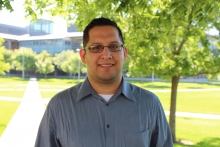 |
Major: Cognitive Science
Home City: Antioch, CA
Contact: rbernal4@ucmerced.edu
Faculty Mentor: Professor Rick Dale
|
Roberto Bernal is a third year undergraduate student expected to graduate in Fall 2018 with a BS in cognitive science and a minor in applied math. He aspires to receive a PhD in cognitive science with the ultimate goal of doing research at a university as a professor. He also wishes to inspire underrepresented students to pursue higher education in the sciences. Right now, Roberto has taken advantage of research opportunities by becoming a research assistant in a lab on campus. Aside from doing research, he enjoys meeting new people whether it be outside of college or in college settings. As a member of the Cognitive Science Student Association he enjoys talking to people, going to conferences, and being able to provide resources and relevant information to students pursuing a cognitive science major. Roberto is really proud of being able to transfer to a 4 year university from a community college. As a first generation college student, he feels very accomplished to be able to attend as well as do research at a 4 year university.
The Relationship between Social Network Connectivity and Positive Emotion Word Use
Roberto Bernal, David W. Vison, and Rick Dale, PhD; Cognitive and Information Sciences, University of California, Merced
Linguistic Inquiry and Word Count (LIWC) is a quantitative text analysis program that uses word count strategies to extract psychological and social meaning out of the words people use (Pennebaker et al. 2003). Another method of studying word use is by analyzing social network structures and predicting general language patterns through network analysis and information theory (Vinson and Dale 2016). This study inspects datasets from Yelp and examines the relationship between measures of social network connectivity and positive emotion word use (e.g., love, nice, sweet). The number of friends each user has is a simple measure of social network connectivity. Positive emotion word use is measured by analyzing business reviews of Yelp users using LIWC. We run a linear correlation between users’ number of friends (connectivity) and the percentage of positive emotion words in their respective reviews. Results suggest that users with more friends tend to write reviews with less positive emotion words. We further explore relationships between other LIWC word categories and the number of friends and run linear regression models using these LIWC word categories to determine if we can predict the number of friends by the words people use. Extending these findings to other social networks such as Twitter and Facebook will generalize the results and make a stronger theoretical case.
Andrew Betancourt
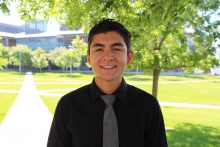 |
Major: Biological Sciences
Home City: Temecula, CA
Contact: abetancourt2@ucmerced.edu
Faculty Mentor: Professor Nestor Oviedo
|
Andrew Betancourt is a fourth-year undergraduate student originally from Temecula, CA. Andrew is graduating in the spring of 2018 with a Bachelor's of Science in Human Biology. He aspires to obtain a master's degree in biology and then attend medical school to fulfill his dream of becoming a pediatric oncologist. Andrew hopes to put a check mark on his bucket list by eventually practicing medicine in Doctors Without Borders. Andrew has recently begun volunteering in the Emergency Department at the Emanuel Medical Center in Turlock and serves as the President of the American Medical Student Association at UC Merced. Andrew is passionate about leadership, advocacy, and strives to inspire and motivate students to pursue careers in health and medicine.
Identifying the Molecular Landscape Driving Cellular Transformation
Andrew Betancourt, Manish Thiruvalluvan, Melanie LeGro, and Nestor J. Oviedo, PhD; Molecular and Cell Biology, University of California, Merced
Replicating with DNA damage is a key step in tumorigenesis. Previously, we created a model for genomic instability through RNA interference of Rad51, a critical component of DNA repair through homologous recombination in the planarian model organism Schmidtea mediterranea. Knockdown of Rad51 results in massive cell death in the tail region, while cells continue dividing with DNA damage in the anterior part of the body. Cellular division in the presence of DNA damage is a pervasive feature of cancer cells. Thus, our goal is to identify what underlying mechanisms enable cellular division carrying DNA damage. To this end, we performed high throughput RNA sequencing between the anterior and posterior region following Rad51 knockdown and identified 30 genes that are differentially expressed. Five candidate genes were selected based on their high expression in stem cells. Candidate genes were cloned and we are performing functional validation analyses to identify the molecular network controlling cellular division in the presence of DNA damage. In addition, double-RNAi experiments will reveal if the any of these candidates could rescue the Rad51 RNAi organisms. One or two genes may be selected for in depth analysis of their effects of planarian tissue homeostasis. Execution of these experiments may lead to the identification of novel molecular targets to treat cancer without disturbing tissue physiology.
Christina Blaul
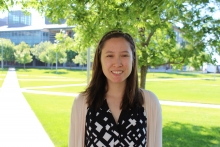 |
Major: Biological Sciences
Home City: Marina, CA
Contact: cblaul@ucmerced.edu
Faculty Mentor: Professor Kara McCloskey
|
Christina Blaul is a rising junior undergraduate researcher. She has an interest in stem cell culturing and tissue bioengineering. Christina has many places she would call her hometown, as she spent a lot of her childhood on different military bases. She currently resides in a small town between the beautiful Monterey peninsula and the agriculturally rich Salinas Valley. Her academic goals include going to graduate school to further her education in Biology. She wants to study medicine to innovate health applications. Christina is deeply involved in both political and health issues in her community. She loves running and spending time in nature, which can be multi-tasked. Christina has always been curious about the world, and has a passion to search for answers about the natural world.
Testing the Fibrin, Thrombin and Aprotin Ratios in Sera-Free Tip/Stalk and Phalanx ESC-AEC/EC Cultures
Christina Blaul1, Kara E. McCloskey, PhD2, and Nicole Madfis, PhD2; School of Natural Sciences, University of California, Merced1; School of Engineering, University of California, Merced2
Endothelial cells (ECs) are used to engineer tissue grafts, and translational research in regenerative medicine. Mouse embryonic stem cells (mESCs) are induced to differentiate into EC subpopulations through mechanisms of in vitro fertilization, monolayers, or by gene therapy. Derived from stem cells, specifically mESC, the endothelial progenitor cells are isolated to differentiate proliferating populations of vascular endothelial. The specific venous, arterial and lymphatic ESC-derived EC lineages have not been studied as separate branches. The distinct features of specialized EC subpopulations have not been explored after the outgrowths of Flk-1+ in vascular progenitor cells. These specialized EC are the components found in branching blood vessels. This area of study has the potential to create fully functional arteries and veins for an injured heart. Growing homogenous sub-cultures of proliferating sera-free stem cell-derived(ESC)-ECs requires a balanced thrombin to fibrinogen ratio. Thrombin and fibrinogen blood clots are gel-like growth factors that stimulate sprouting on angiogenic endothelial cells. During a 7-10 day period, having a higher concentration of aprotein to thrombin inhibits protiasis. Mimicking the same fibrin concentration will optimize the protocol, while decreasing cell count. The purpose of the expirement is to optimize the fibrin stability so that it lasts up to one week. To what extend can the fibrin-thrombin ratio optimize the cell count and parameters of angiogenic tip/stalk phalanx endothelial subpopulations. Cells were implanted in a microfluidic device with extremely small scaled channels of networks that the media is pipetted through for feeding.
Salvador Castaneda Barba
Salvador Castaneda Barba is a third-year undergraduate student who is expecting to graduate spring of 2019 with a BS in Molecular Biology. During his three years at the University of California, Merced, Salvador has been a very active member in our campus' community but would like to continue to make his mark through conducting research. As a Founding Father and Vice President of Education for Pi Lambda Phi Fraternity, Salvador discovered the value in helping others around him succeed and would like to continue helping others after he graduates. Once he acquires his BS, Salvador aspires to earn a Ph.D. in molecular biology with the end goal of becoming a professor while also conducting research. During his free time, Salvador enjoys watching shows, movies, as well as watching and playing soccer.
Minimum Inhibitory Concentration of Solithromycin against E. Coli that cause Urinary Tract Infection
Salvador Castaneda Barba, and Miriam Barlow, PhD; School of Natural Sciences, University of California, Merced
Solithromycin is an antibiotic that is currently in phase 3 of clinical development for the treatment of moderate to moderately-severe bacterial pneumonia and urethritis. This antibiotic affects 50s ribosomal subunit formation and function by binding to three sites on the ribosome. Binding to three sites enables solithromycin to increase its ribosomal binding and reduces propensity to known resistance mechanisms. In this study, 48 E.coli isolates from patients with urinary tract infection were analyzed for susceptibility to this antibiotic. This was done through minimum inhibitory concentration testing at a concentration range from 1 ug/ml to 32 ug/ml. The experiment revealed that at a concentration of 16 ug/ml, 45 of the strains were susceptible to the antibiotic. The remaining 3 strains were susceptible at a concentration of 32 ug/ml. While the concentration obtained was high, it shows that none of the strains developed resistance and that Solithromycin is effective in treating E. coli as well as other previously demonstrated bacteria such as Streptococcus pneumoniae and Staphylococcus aureus.
Michael Chi
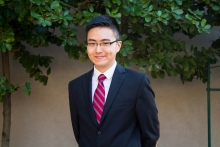 |
Major: Biological Sciences
Home City: Walnut Creek, CA
Contact: mchi3@ucmerced.edu
Faculty Mentor: Professor Jennifer Manilay
|
Michael Chi is a second year undergraduate who is majoring in biological sciences and minoring in public health. He will be graduating from the University of California, Merced in May of 2019. After receiving his diploma, he plans to attend either graduate school or medical school to pursue his long term goal of helping cancer patients achieve complete remission. To Prepare for this daunting task as an undergraduate, he has been participating in the American Medical Student Association, from which he earned a certificate of achievement for reaching bronze membership, and conducting academic rsearch on the current state of cancer research, specifically on a revolutionary new field of cancer therapy that targets HOX genes. He has also been asking his biology professors on their knowledge of HOX genes and how they could potentially be used to treat various forms of cancer. With this collective knowledge, Michael intends to turn theory into practice during his time at the SURF program.
Study of the Role of Sclerotin on Expression of Self-renewal Genes in Hematopoietic Stem Cells
Michael Chi, Christie Donham, and Jennifer O. Manilay, PhD; School of Natural Sciences, University of California, Merced
Our goal is to analyze the expression of self-renewal genes in long-term hematopoietic stem cells (LT- HSCs) in wild-type and sclerostin (SOST) knockout mice. LT-HSCs give rise to all blood cell types throughout life, and expand via a process known as self-renewal. The SOST protein is secreted from osteocytes (mineralized bone cells) and previous studies suggest that when the expression of the SOST protein is removed, there is a significant increase in LT-HSC numbers and/or differentiation ability. Our hypothesis is that in the absence of SOST, the Wnt signaling pathway in LT-HSCs is not inhibited, which in turn enhances LT-HSC self-renewal and differentiation. Therefore, to investigate if SOST inhibits self- renewal genes in LT-HSCs, we studied the expression of the known self-renewal genes (Bmi1, CyclinD1, HoxB4, and Wnt3a) in both wild type and SOST knockout mice. We expect that these self-renewal genes will be upregulated in the SOST knockout mice. To test our hypothesis, we are optimizing experimental protocols for quantitative real-time polymerase chain reaction (qRT-PCR), in order to quantify self-renewal gene levels. This procedure will help to identify potential molecular and cellular mechanisms involved in activating and controlling the self-renewal and differentiation of LT-HSCs, which are critical for maintaining all blood cell types in adults.
Robert Degen
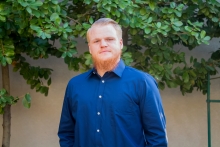 |
Major: Biological Sciences
Home City: Vallecito, CA
Contact: rdegen@ucmerced.edu
Faculty Mentor: Professor Dan Edwards
|
Robert is a third year undergrad with an emphasis in Ecology/Evolution and a heart for conservation. His interest in evolutionary biology stems from his love of animals and a desire to learn more about them, including how they evolve. This exends into a love for ecology as he hopes to see how the two disciplines can share ideas and work with one another. His ultimate goal is to work towards a master's degree and use his education towards future conservations efforts. As an outdoorsman who enjoys activities such as hiking, hunting, and fishing, he wants to preserve the world's natural beauty so everyone can enjoy it as much as he does.
Uta Stansburiana Coloration Study
Robert Degen, Justin Yeager, Kinsey Brock, and Dan Edwards, PhD; School of Natural Sciences, University of California, Merced
In animals, coloration and patterning can serve multiple functions including cryptic coloration to aid in predator avoidance and social coloration to aid in inter/intraspecies signaling. Additionally, these coloration types evolve differently as natural selection heavily affects cryptic coloration evolution while sexual selection affects the evolution of social coloration. One species whose coloration has been studied extensively is the common side splotch lizard (Uta Stansburiana). These studies focused on the function of the three different color morphs found among the species and the biological “rock-paper-scissors” game caused by the competition between these morphs. These morphs appear discrete by the description of their function in social signaling but the coloration itself does not always appear discrete in nature and highlights how little is known about this. Additionally, it is largely unexplored how coloration among populations respond to local habitats. descriptive project aims to investigate coloration in these animals using the most advanced techniques in multispectral imaging to analyze ultraviolet and visual spectra images from roughly 450 individuals. We will compare things chromatic contrast, achromatic contrast, pattern contrast against local habitats, and UV signaling while looking for differences within populations, between populations, and between sexes. We will then measure these comparisons according to the visual sensitivities of different observer species (lizards, snakes, and birds). This analysis will then give us insights into the cryptic and social coloration of this species and what forms of selection drive the diversity seen in their coloration.
Valeria Flores
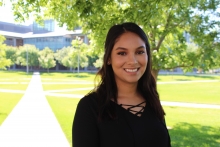 |
Major: Biological Sciences
Home City: Merced, CA
Contact: vflores25@ucmerced.edu
Faculty Mentor: Professor Andrea Joyce
|
Valeria Flores is currently a third year undergraduate student from Merced, CA and will receive her BS in Biology with a minor in Public Health in Spring of 2018. As a member of Bobcat Strength and Public Health Society, Valeria believes in promoting overall health and well-being to the community. In her free time, Valeria enjoys exploring new places, indulging in new dining experiences, and embracing different cultures. She aspires to attain a Master's in Public Health and in Physician Assistant Studies to eventually work in an underrepresented community such as Merced so she can be a first hand advocate for those who do not have immediate access to healthcare.
Wolbachia Infection in Merced County Mosquitos
Valeria Flores, Ryan Torres, Eunis Hernandez, and Andrea L. Joyce, PhD; Public Health, University of California, Merced
Wolbachia are a group of bacteria present in the reproductive organs of arthropods and nematodes. They are known to alter the biology of the infected organism to increase its own likelihood of transmission. Both male and female host organisms can be infected, however only females are capable of transmission. Wolbachia have evolved four ways to manipulate host reproduction to their favor. These four ways include feminization, parthenogenesis, male killing, and cytoplasmic incompatibility. Cytoplasmic incompatibility, the most common manipulation, occurs when a male infected with Wolbachia mates with a female infected with a different Wolbachia type or a non-infected female. Due to their natural ability to directly influence reproduction, Wolbachia have been of increasing interest as a control measure for mosquito-borne viruses. In this study, the presence of bacteria was examined in mosquitoes found in Merced County in order to improve current knowledge and explore future possibilities for release of infected mosquitoes. To accomplish this, mosquitoes were collected and identified to species, DNA was extracted, and then PCR was used to investigate the presence or absence of Wolbachia and which subgroup it belonged to. It is hoped that with the obtained results, progress will be made to control the spread of mosquito-borne diseases.
Jose Garcia
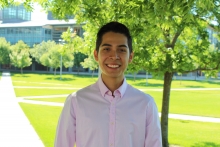 |
Major: Biological Sciences
Home City: San Diego, CA
Contact: jgarcia333@ucmerced.edu
Faculty Mentor: Professor Mark Sistrom
|
Jose Garcia is a third year undergraduate from San Diego, California. Expected to graduate in Spring 2018 with a BS in Biological Sciences. Jose has been an active member of UC Merced by being involved within the Campus Activities Board, Delta Epsilon Mu Fraternity and Office of International Affairs. To relax, Jose enjoys going on adventures with his friends and watching Netflix. One day, Jose hopes to have a PhD in Epidemiology and serve organizations like the WHO, CDC or NIH to help keep the world's population safe.
Antibiotic Resistant Bacteria in Central Valley Wastewater Systems
Jose Garcia, Lauren Brooks, PhD, and Mark Sistrum, PhD; School of Natural Sciences, University of California, Merced
Leakage of antibiotic-resistant organisms into water environments pose an increased risk of spreading resistance genes and altering microbial ecosystems. Wastewater treatment plants utilize heavy antibiotics to neutralize microbes before release, but overuse of the antimicrobial agents in hospitals and farms have decreased the effects over time. With the large agricultural influence in California’s Central Valley, it is necessary to investigate the prevalence of antibiotic resistance bacteria in wastewater treatment plants to improve upon antimicrobial practices. We hypothesized that methicillin-resistant Staphylococcus aureus (MRSA) and carbapenem-resistant Klebsiella pneumoniae will be present in wastewater from agricultural regions of the Central Valley. Influent wastewater samples from Merced, Mariposa, Modesto, Fresno, and Los Banos were screened on antibiotic plates, cultured, and ran through PCR. Presence of MRSA and K. pneumoniae were detected in all five sample sites. Statistical relationships and significant of impact will later be analyzed. The data generated will help map microbial evolutionary pathways through artificial and natural water environments across the Central Valley and ultimately, be used to improve antimicrobial treatment practices in agricultural regions.
Hamelmal Gobezie
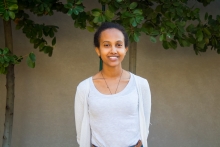 |
Major: Applied Mathematics
Home City: San Jose, CA
Contact: hgobezie@ucmerced.edu
Faculty Mentor: Professor Emilia Huerta Sanchez
|
Hamelmal Govezie is a senior undergraduate from San Jose, CA expected to graduate in Spring of 2018. Hamelmal is taking steps that can help her get a job upon graduation and continue her education in a master's program. These steps include conducting research on campus and being part of summer programs that can help her develop useful skills. During the academic year, she is an active member and a past club officer of National Society of Black Engineers. This club has helped her grow professionally as a student and helped her network with companies during national conferences. She also believes in helping the community by volunteering her time and using her connections. She is able to achieve this goal of hers through Rotaract; a club that goes out to help the Merced community every weekend. In addition, Hamelmal also loves to dance during her free time and thrives to be the best she can be.
Population Structure and Local Adaptation Through the X-Chromosome
Hamelmal Gobezie and Emilia Huerta-Sanchez, PhD; School of Natural Sciences, University of California, Merced
One fundamental question in human evolutionary biology is understanding how humans adapted to their local environment. We will investigate how selective pressures and demographic factors have affected the observed genetic variation on the female X chromosome. Through the usage of public data sets provided by the 1000 Genomes Project, we investigate local large frequency differences in closely related populations. Between two populations, we can measure genetic population differentiation, FST. A value of 0 may be interpreted as the two populations being genetically similar and 1 as the two populations being genetically different. We are looking at 26 different populations, therefore we will have 325 pairwise comparisons. We use the relationship between Maximal Allele Frequency Difference vs FST Global as the null module. That is, when pairs of populations do not follow this expectation, this may be interpreted as a signal of local adaptation in one of the populations. From here we will ask questions like: are these local frequency differences within genes, what does the region look like, are there other variants nearby that have frequency differences, what does the region look like, are there other variants nearby that have frequency differences, what is their position, and more. The goal is to identify and characterize signatures of local adaptation on human X chromosomes.
Karen Gomez
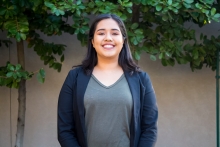 |
Major: Sociology
Home City: Gustine, CA
Contact: kgomez32@ucmerced.edu
Faculty Mentor: Professor Paul Almeida
|
Karen Gomez is a third year undergraduate student from Gustine, CA. She will be a part of the graduating class of Spring 2019 with a BA in Sociology. Karen has begun to make her mark at UC Merced, by conducting research and being heavily involved in her community. She serves as an officer for the Sociology Club and is an active member in SALE. Karen believes it is important to be engaged within her community, whether that is by volunteering her time or organizing events. To destress, she likes to curl in bed with a good book or Netflix however, she also enjoys traveling around California. She aspires to receive her PhD in Sociology and continue researching, while inspiring future generations with similar backgrounds.
Reconstructing the Immigrant Rights Movement of 2006: Bakersfield, CA
Karen Gomez, Maria D. Mora, MA, and Paul D. Almeida, PhD; School of Social Sciences, Humanities, and Arts, University of California, Merced
The Immigrant Rights Movement of 2006 is one of the largest mobilizations for immigrant rights in U.S. history, yet relatively little scholarly attention has been given to these mobilizations in marginalized regions and low-income cities. I conducted a case study analysis of a central valley city, Bakersfield, using a mixed- methods approach by conducting interviews of key organizers and participants along with newspaper documentation of protest events and secondary sources. My findings reveal that the legal threat of anti- immigrant law HR 4437 was present in Bakersfield but the threat alone was not enough for mobilization, framing and coalitions were also important. I also examined outcomes of the 2006 movement and found two key outcomes: 1) sustained mobilization and 2) change in consciousness of the community.
Samantha Hernandez
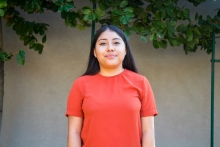 |
Major: Biological Sciences
Home City: Los Angeles, CA
Contact: shernandez228@ucmerced.edu
Faculty Mentor: Professor Jennifer Manilay
|
Samantha Hernandez is a first-year undergraduate student from Los Angeles, California. Expected to graduate in Spring 2020 with a BS in Biology. Samantha has begun to make her mark at the University of California, Merced by being an active member in her community. As President of her community council residence hall association, she has demonstrated her commitment to serving others. Samantha thinks that she can be of the most help serving students that as are also first generation students. That is why she has devoted her time to programs that help motivate underserved students. With the extra time she has, she finds herself going out for boba and taking trips to Yosemite lake to destress. She aims to achieve a MD, and her goal is to become a woman that serves underserved communities.
Investigating the Role that VHL-deficiency plays in B Cell Development and Immune Response
Samantha Hernandez, Betsabel Chicana, MS, and Jennifer O. Manilay, PhD; School of Natural Sciences, University of California, Merced
B cells are important immune cells that are required for effective immune responses to protect the body against pathogens. Previous experiments have shown that conditional knockout of the von-Hippel Lindau (VHL) gene in osteocytes leads to an increase of bone mass, therefore leaving diminutive room for the bone marrow. We have also observed that these VHL-deficient mice have a reduction in B cell progenitors in the bone marrow, as well as decreased mature B cells in the spleen, although some mature B cells do develop. We hypothesize that mature B cell function after immune challenge is altered with VHL-deficiency. In this study, we investigated the functional response of B cells in VHL-deficient mice in response to immunizations. The immunizations used included the model antigens NP-Ficoll and NP-OVA to induce T- dependent and T-independent B cell responses. We will compare responses in control and VHL-deficient mice to determine the effect of VHL on B cell function, using enzyme linked immunosorbent assays (ELISA’s) to quantify antibody titer levels after immunization. Since B cell frequencies are reduced in VHL- deficient mice, I expect to observe lower levels of antigen-specific IgM, IgG3 and IgG1 levels in VHL- deficient mice compared to controls. The results from this study will help better understand B cell immunity in the absence of the VHL gene, and could inform how changes in bone homeostasis affects immune function.
Genesis Higueros
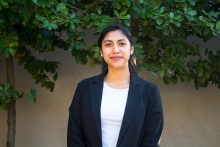 |
Major: Environmental Engineering and Applied Mathematics
Home City: Novato, CA
Contact: ghigueros@ucmerced.edu
Faculty Mentor: Professor Gerardo Diaz
|
Genesis Higueros is a third year undergraduate student from Novato, CA and is expected to graduate in Spring 2020 with a BS in Environmental Engineering and Applied Mathematics. Genesis has begun to make an impresion at the University of California, Merced by conducting research and being an active member in her community. As an Earth Club member, Genesis passionately serves the Merced community through local projects. When it comes to the environment, she believes it is important to take action within her region first. Genesis has worked for nonprofit organizations, such as Mujeres Usando los Pantalones and EarthScope Media, and regularly volunteers at annual conferences, including the Women's Empowerment and Splash conference, where she has spoken of environmental conservation and sustainability. To unwind, Genesis finds herself painting, reading and taking trips to Yosemite. She aspires to achieve a PhD in engineering, and her ultimate goal is to be a woman who can inspire the world's youth to pursue higher education and environmental sustainability.
Physical Activation of Peach Pit Derived Char and the Effects of Activation Time Length on its Surface Properties
Genesis Higueros, Andres Munoz Hernandez, and Gerardo Diaz, PhD; School of Engineering, University of California, Merced
Pyrolysis and gasification of waste biomass produces biochar, a porous carbonaceous material most commonly used for soil amendment, but also applied to water treatment and carbon sequestration. Activated carbons have larger surface areas in the range of 1000 to 2000 m/g, and porosity that removes contaminants more efficiently than biochar. Activated Carbon is generally derived from coal or coconut shells, which are mainly imported from Asia. The adsorptive properties of activated carbon depend on the activation parameters such as temperature, time, and atmosphere. Published results have shown that optimum properties for activated carbon are usually obtained for temperatures in the 800°C range and for activation times at which around fifty percent of the mass is lost. The objective of the project is to determine the physical activation parameters that result in optimum surface properties for peach pits derived biochar. In the preliminary experiments, pre-dried samples of biochar were tested at different activation times in a furnace at temperatures near 800°C. Steam was used as the activation agent, and nitrogen gas was used to cool the samples to around 200°C. After drying the samples, the mass loss was determined. The Brunauer- Emmett-Teller (BET) surface area, pore size distribution, and volume fraction will be obtained. Surface areas in excess of 1000m2/g are expected which will be considered good results.
Sabrina Lauv
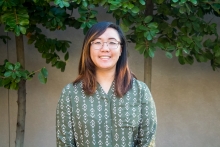 |
Major: Computer Science and Engineering
Home City: Lake Elsinore, CA
Contact: slauv@ucmerced.edu
Faculty Mentor: Professor Yangquan Chen
|
Sabrina Lauv is a second year undergraduate from Lake Elsinore, CA. She is expected to graduate in Spring 2019 with a BS in Computer Science and Engineering. She has already shown her desire to help others with her involvement in the Association for Computing Machinery (ACM) and UC Merced, a club for those who are interested in programming and which offers tutoring. She also shows active involvement in campus through her campus job as an intern at OSL in which she creats and runs events for students to get involved and enjoy. Sabrina strives to achieve a PhD in Computer Science and Electrical Engineering in hopes to push the bounds of the new technological movements in Computer Science.
Unmanned Aerial Vehicle (UAV) Precision Landing: Improvements for Recharging Applications and Future Prospects
Sabrina Lauv, Tiebiao Zhao, Michael Andemeskel, Edgar Perez-Lopez, Alejandro Molina, and YangQuang Chen, PhD; School of Engineering, University of California, Merced
Unmanned Aerial Vehicles (UAVs) have found uses across multiple industries through delivery, rescue, military and other services. However, limitations remain due to a drone’s low battery life and the costly necessity of manual battery replacement by the pilot. Autonomous battery swapping can be achieved by having the drone land precisely on a charging station and will reduce costs and increase its efficiency. GPS precision landing can be up to 1 meter off target, so other methods need to be investigated. Our team addresses the precision landing phase by using a lidar, infrared (IR) sensor, and target paired with the IRIS+ drone platform. The results of the project will be used to modify drone landing precision to within 30 cm of the target.
Eric Lebish
 |
Major: Biological Sciences
Home City: Livermore, CA
Contact: elebish@ucmerced.edu
Faculty Mentor: Professor Anna Beaudin
|
Eric Lebish is a second-year undergraduate student from Livermore, CA. He is expected to graduate in Spring of 2019 with a BS in Biological Sciences. In addition to conducting research at the University of California, Merced, Eric is an officer of AMSA and is a member of Delta Epsilon Mu. Eric is a huge advocate for the bringing the UC Merced community into the Merced community, and joining these organizations has allowed him to help other students learn and participate in off-campus events and organizations. Eric plans to continue his education in the health field after completing his Bachelor's. In his free time Eric likes to read and watch movies.
The Quantification of IgM to Detect Changes in Immune Function Following Development Perturbation
Eric J. Lebish, April Apostol, and Anna E. Beaudin, PhD; School of Natural Sciences, University of California, Merced
B1-B cells reside in the peritoneal cavity (PerC) where they mediate tolerance and initiate a rapid response to an infection through the production of natural antibody, Immunoglobulin M (IgM). B1-B cells are only produced during fetal development, and our lab has recently identified a developmentally restricted hematopoietic stem cell (drHSC) that gives rise to innate-like lymphocytes, including B1-B cells. Our lab further demonstrated that perturbation during fetal development, such as maternal infection, leads to sustained expansion of the B1-B cell population in postnatal life. Our goal is to determine whether developmental perturbation leads to an increase in natural IgM production from the expanded B1-B cell population. We hypothesized that there will be higher amounts of IgM detected in both the serum and PerC in neonates following developmental perturbation. To test our hypothesis, we will use an enzyme linked- immunosorbent assay (ELISA) to quantify the amount of IgM in the PerC and the serum. We will compare the IgM levels in the samples taken from the offspring of treated dams to control offspring. Our results from these studies will define the impact of developmental perturbation on immune function across the lifespan.
Lisette Manriquez
 |
Major: Cognitive Science
Home City: Oakland, CA
Contact: lmanriquez2@ucmerced.edu
Faculty Mentor: Professor Ramesh Balasubramaniam
|
Lisette Manriquez is a fourth year undergraduate student from Oakland, CA. She is graduating in the spring of 2018 with a BS in Cognitive Science. Lisette has a strong dedication to behavioral neuroscience and psychiatry. She has previous research experience in public health, neuroscience, genomics, biology and the behavioral sciences. Lisette previously assisted in single cell genomic research for Lawrence Berkeley National Laboratory at Joint Genome Institute. Lisette works closely with patients who suffer from neurodegenerative diseases, traumatic brain injuries and mental illness. To destress, Lisette likes to read about Buddhism and take camping trips. Lisette plans to become a psychiatric nurse practitioner to help reform psychiatric treatment in underserved communities like Oakland, CA.
Exploring the Neural Processes of Beat and Meter Perception using EEG
Lisette Manriquez, Daniel Comstock, and Ramesh Balasubramaniam, PhD; Sensorimotor Neuroscience Lab; Cognitive and Informational Sciences, University of California, Merced
The perception of beat and meter is both essential and fundamental to every music experience. However, the neural processes underlying beat and meter perception remains unknown. The resonance theory for beat and meter perception suggest that beat perception is the entrainment of neuronal populations resonating at the beat frequency, producing higher-order resonance at subharmonics of beat frequency, corresponding to the meter. In this replicated study, we use electroencephalogram to confirm the theory that perception of beat and meter emerges from the entrainment of neurons resonating to the beat and meter. We hypothesize that the electrocortical activity generated by populations of neurons resonating to the frequency of the beat and meters presented, can be captured in the EEG. To test this, EEG is recorded on subjects while they listen to a rhythm of tones with a 2.4 Hz beat while imagining the meter of the beat as either binary or ternary. We predict that the beat will elicit electrocortical activity at the beat frequency (f = 2.4 Hz) and at the frequencies of the imagined binary (f = 1.2 Hz) and ternary (f = .8 Hz) meters. Our findings compare the electrocortical activity with the frequencies of the beat and imagined meters, as well with the original study being replicated. These results can provide closer insight into the dynamic cognitive processing of music and serves as compelling evidence of whether neural entrainment to beat and meter can be captured using EEG. Future studies can be performed using independent component analysis and dipole source localization with this data to locate and determine the neural components involved to further our understanding.
Gustavo Montero Contreras
Gustavo Montero C. is a fourth-year undergraduate student from Atwater, CA who transferred from Merced College during spring 2016 and is expected to graduate in spring 2018 with a B.S. in Mechanical Engineering. Gustavo has begun to make his mark at the University of California, Merced by conducting research and having a greater rol in his family and community by achieving his goals and inspiring others to achieve their goals. Gustavo knew that pursuing a college degree was going to be challenging therfore he enrolled in DARTS and UROC has made it more possible to reach his goals. As a first-generation college student in his family, Gustavo knows how hard it has been to get where he is and how hard it will continue to be. To relax, Gustavo enjoys calm meditation and enjoys the small victories that come with solving problems and helping others understand them. His future academic and career goals include obtaining a Master's in Mechanical Engineering or Business Administration and obtain a Professional Engineering licensure. Ultimately. he wants to be a good person with no regrets and serve as a role model of success for others from a similar background to look up to for guidance and inspiration.
Topology Optimization of Material Discontinuities (MD) Patterns in Origami-Based Sheet Metal (OSM) Bending Using Finite Element Analysis
Gustavo Montero Contreras, Muhammad Ali Ablat, and Ala Qattawi, PhD; School of Eningeering, University of California, Merced
Origami-based sheet metal (OSM) bending seeks to increase bending accuracy and reduce the high cost needed to bend a sheet metal part to the desired angle. This goal is achieved by instituting material discontinuities (MD) in the form of perforations to the sheet metal prior to bending. Previous study shows that implementing MD along the desired bending line would reduce bending forces and energy use. However, undesired stress concentrations are formed due to MD patterns. For MD to be more effective with lower bending force requirements and stress concentration, topology optimization is necessary. Therefore, this study aims to discover optimal topology that meets said requirements on three different MD patterns. Desired topology of MD is achieved using commercial finite element software ANSYS. The outline to achieving the desired topology consists of performing a bending simulation on sheet, running topology optimization process on results, extracting optimized MD pattern and validating new MD pattern by performing bending simulation with improved MD. Since the objective of the current work is to reduce stress concentrations, this work attempts to analyze current MD’s with an emphasis in Global Von-Mises Stress optimization analysis seeking to cooperate or improve upon existing MD’s. Derivations and relations of existing MD’s to each other also observed.
Vicente Morales
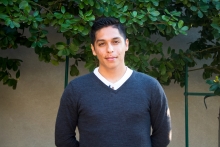 |
Major: Biological Sciences
Home City: Compton, CA
Contact: vmorales6@ucmerced.edu
Faculty Mentor: Professor Rudy Ortiz
|
Vicente Morales is a fifth year undergraduate student from Compton, CA. Vicente expects to graduate in Spring 2018 with a BS in Microbiology and Immunology. Currently at UC Merced, Vicente holds leadership positions in MECHA De UCM and Chicanxs in Health Education. These organizations are important to Vicente because they are direclty invloved with exposing and reducing health disparities and being connected to underserved communities. As a pass time, Vicente is a film enthusiast and finds comfort in playing various mucial instruments. His ultimate career goal is to one day manage programs that provide resources to the children living in underserved communities and to do research involved with health issues that directly affect Latinxs and people of color.
Angiotensin Receptor Blockers Prevents Acute Kidney Injury in Insulin Resistant Rats
Vincente Morales1, Esteban Sandoval1, Akira Nishiyama2, Alicia McDonough3, and Rudy M. Ortiz, PhD1; Department of Cellular and Molecular Biology, University of California, Merced1; Department of Pharmacology, Kagawa University Medical School2; Department of Medicine, Keck School of Medicine, University of Southern California3
Acute kidney injury (AKI) can be exacerbated by diabetes, which is also associated with an inappropriately elevation in the renin-angiotensin-aldosterone system (RAAS). However, the contribution of elevated RAAS to AKI during the manifestation of diabetes is not well-defined. Here we tested the hypothesis that chronic blockade of AT1 ameliorates AKI in insulin resistant rats. AKI was induced by right kidney nephrectomy and an acute renal artery ischemia for 30 minutes. Three groups were used: (1) Long-Evans Tokushima Otsuka (LETO; control; n = 10), (2) insulin resistant, Otsuka Long-Evans Tokushima Fatty (OLETF; n = 7) rats, and (3) OLETF + angiotensin receptor blocker (OLETF+ARB;n=8; 10 mg olmesartan/ kg/d x 6 wks). The urinary excretion ratios (mmol/mmol?) of Na+ and K+ to creatinine were measured for 3 hrs at hour-long intervals (T0, T1, T2, and T3). At T3 the average UNa;CreatV increased by 112% in LETO, and decreased by 29% in OLETF, while ARB stabilized levels consistent with LETO. At T3 the average UK:CreatV increased by 153% in LETO, and decreased by 43% in OLETF, while ARB stabilized levels to an even greater extent than in LETO (only increasing by 41%). The development of insulin resistance impairs the renal regulation of Na+ and K+ in response to acute kidney injury that is ameliorated by chronic blockade of AT1.
Rocío Murillo
 |
Major: Sociology
Home City: Los Angeles, CA
Contact: rmurillo8@ucmerced.edu
Faculty Mentor: Professor Paul Almeida
|
Rocío Murillo is a third year undergraduate student from Los Angeles, CA. She is currently majoring in Sociology with a Natural Sciences Education (NSED) minor, and aspires to get her PhD in Sociology. Expected to graduate in spring 2019, Rocío has already begun to make her mark at the University of California, Merced by being an active member in her community. As a CalTeach student, she has interned with the Merced County Office of Education to help local families and children in the community. In addition, she presented lesson plans to 7th grade students in Southern California, through an externship with NatureBridge. At UC Merced, she is the President of the Sociology Club and during her free time, Rocío enjoys visiting the beach and drawing intricate mandalas.
Reconstructing the Immigrant Rights Movement of 2006 in Stockton, CA
Rocío Murillo, Maria Mora, MA, and Paul Almeida, PhD; School of Social Sciences, Humanities, and Arts, University of California, Merced
The Immigrant Rights Movement of 2006 is one of the largest mobilizations for immigrant rights in U.S. history, yet relatively little scholarly attention has been given to these mobilizations in marginalized regions and low-income cities. I conducted a case study analysis of a Central Valley city, Stockton California, using a mixed-methods approach by conducting interviews of key organizers and participants along with newspaper documentation of protest events and secondary sources. My findings reveal that the legal threat of anti-immigrant law (HR 4437) was present but threat alone was not enough, other key conditions influencing the level of mobilization were: framing and coalitions. I also examined the outcomes of the 2006 movement: 1) Change in consciousness of the community and 2) Sustained mobilization.
Valezka Murillo
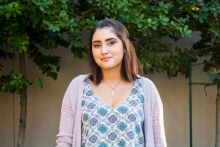 |
Major: Sociology
Home City: Los Angeles, CA
Contact: vmurillo3@ucmerced.edu
Faculty Mentor: Professor Paul Almeida
|
Valezka Murillo is a second year undergraduate student from Los Angeles, CA. She is expected to graduate in the Fall of 2018 with a BS in Sociology and has already began to make her mark at UC Merced. Valezka is an active writer for the school newspaper, The Prodigy, and volunteering for the Women's Programs. She believes strongly in working towards increasing the diversity and intersectionality on her campus. To destress, Valezka enjoys listening to music and watching documentaries. She aspires to become an attorney and provide aid to marginalized groups in her hometown of Los Angeles.
Reconstructing the Immigrant Rights Movement of 2006 in Porterville, California
Valezka Murillo, Maria Mora, MA, and Paul Almeida, PhD; School of Social Sciences, Humanities, and Arts, University of California, Merced
The Immigrant Rights Movement of 2006 is one of the largest mobilizations for immigrant rights in U.S. history, yet relatively little scholarly attention has been given to these mobilizations in marginalized regions and low-income cities. I conducted a case study analysis of Porterville, California using mixed methods by conducting interviews of key organizers and participants along with newspaper documentation of protest events and secondary sources. My findings reveal that the legal threat of the anti-immigrant law (HR 4437) was present in all communities but threat alone was not enough, other key conditions also influence the level of mobilization: framing, coalitions, and community support. I also examine outcomes of the 2006 movement: 1) sustained mobilization. I found that there was no sustained mobilization after the massive 2006 demonstrations. In conclusion, this project closely examines the immigrant’s rights movement in the city of Porterville and sheds new light on the previously ignored immigrant rights activism of the Central Valley.
Julio Perez
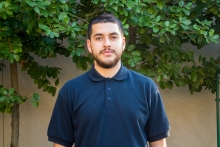 |
Major: Mechanical Engineering
Home City: Hayward, CA
Contact: jperez92@ucmerced.edu
Faculty Mentor: Professor Gerardo Diaz
|
Julio Perez is a fourth-year undergraduate student from Hayward, CA. Expected to graduate in Spring 2018 with a B.S. in Mechanical Engineering, Julio has already begun to make his mark at the University of California, Merced by conducting research and applying that research into a start-up that he is working on. As part of the PG&E Engineering Service Learning he served as the Project Manager for teh UAV Team, where he was able to contribute to the Merced community by introducing local farmers to modern precision agriculture techniques to reduce costs and improve yield. Currently, he is doing research on a joint project with Dr. Gerardo Diaz and Dr. Roland Winston and aspires to achieve a PhD in mechanical engineering with either of these professors' research groups. To distress, Julio finds himself playing soccer and lifting weights. His ultimate goal is to start his own company that aims to make solar energy the new conventional way to power homes.
Modeling of Pressur Drop and Heat Transfer Correlation through EES and Initial Phase of Large Scale Manufacturing
Julio Perez and Gerardo Diaz, PhD; School of Engineering, University of California, Merced
Solar thermal collectors are defined as an energy exchanger that converts solar energy to thermal energy and are often referred to as solar water heaters. Conventional solar water heaters include flat plate collectors and evacuated tubes with a heat-pipe attached to an absorber fin, however, small size of condenser section limits the rate of heat transfer and maintaining vacuum conditions over time can be challenging. A novel minichannel-tube solar thermal collector for low to medium temperature application is analyzed to demonstrate its heat transfer improvement with respect to conventional copper collector. In this study, year- round data collected by thermocouples, flowmeters and additional back-up sensors was analyzed through LabView and EES simulations. Year-round performance showed feasibility to operate on a larger scale. Due to the required precision of the minichannels in the aluminum collector tubes for large scale production, the proposed design had to consider the current manufacturing capabilities available. In order to meet the manufacturer’s extrusion capabilities and keep a low pressure drop and high heat transfer, various dimensions for the aluminum minichannel tubes were simulated with EES. Furthermore, EES allowed us to consider different collector configurations. A previous design manufactured and tested at UC Merced reached a 12% improvement in thermal efficiency with respect to a copper flat plate collector and is currently being manufactured to satisfy the thermal energy needs of a middle school in Southern California.
Yanirong Phok
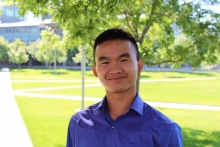 |
Major: Biological Sciences
Home City: Visalia, CA
Contact: yphok@ucmerced.edu
Faculty Mentor: Professor Fabian Fillip
|
Yanirong Phok is a third-year undergraduate student from Visalia, CA. He is expected to graduate in Spring 2018 with a BS in Human-Biology. Yanirong was fortunate to enroll into a 4-year university as a first-generation college student. Yanironghas contributed time to the Merced community through volunteer opportunities provided by being involved as a member of UNICEF and an officer of the AMSA club. Yanirong desires to gain as much knowledge as an undergraduate and inspires to pursue a MD/PhD degree where his goal is to become someone who provides care and contributes to provide advancements in the medical field to inspire future first generation students to accomplish medical breakthroughs.
Biomass Composition and Metabolic Flux Analysis of Melanoma Cells
Yanirong Phok, Amandeep Sanghera, Ajay Bainiwal, Simar Singh, and Fabian Filipp, PhD; School of Natural Sciences, University of California, Merced
With an estimated ten thousand deaths annually in the US [2], Melanoma is one of the most fatal of skin cancer in the United States. Humans are at risk for melanoma due to sun exposure which includes UV radiations resulting in DNA damage and impairment of DNA repair mechanisms. While the genetic basis of changes that facilitate the transformation of a normal cell to a metastatic malignant tumor cell are widely studied, the metabolic adaptations of tumor cells require further investigation. A common feature of cancer cell metabolism is the ability to differentially regulate metabolic pathways and nutrients to both maintain viability and build new biomass [1]. In this experiment, we aim to study how melanoma cells alter their metabolism to support continued proliferation by quantifying their macromolecular composition and creating a biomass equation that represents the data. Our research investigated carbohydrate, lipids, RNA, DNA, and protein. These macromolecules were extracted from three melanoma cell lines and the correlation between the macromolecule concentration and cell number was graphed. RNA and DNA extracts showed a linear graph, while protein extraction exhibited a nonlinear relationship. Further experiments will quantify the lipid and carbohydrate components and integrate these results into a complete biomass equation for use in metabolic flux analysis of melanoma cells.
Abraham Uribe
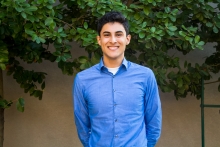 |
Major: Computer Science and Engineering
Home City: Salinas, CA
Contact: auribe9@ucmerced.edu
Faculty Mentor: Professor Florin Rusu
|
Abraham Uribe is a second year undergraduate students from Salinas, CA. He is expected to graduate in Spring 2019 with a BS in Computer Science and Engineering. Ever since his first semester he has been an active student participating in research and competitions like Design Build Fly (DBF). He has even taken on leadership roles such as becoming the webmaster for Ingenieros Unidos, a local chapter of the Society Hispanic Professional Engineers. His goals are to eventually get a master's degree in Computer Science, and return to Salinas to raise awareness of STEM opportunities for hispanic students. On his free time, Abraham tends to play video games, participate in hackathon, and work on side projects.
Basketball Performance Predictions
Abraham Uribe and Florin Rusu, PhD; School of Engineering, University of California, Merced
Predicting the performance of basketball teams is a difficult task due to the uncertainties that may take place during a season of competition. However, using well documented data from the NBA, NCAA , and international leagues, it is possible to predict which teams will best perform for the following season. A team’s potential can be quantified by each Player’s Efficiency Rating. With this rating one can compare the stats of a player with other players to show which team, numerically, has the superior roster. More specifically, one can find a range of team efficiency based on which players are on the courts since only five players per team can actively compete. This method was tested in a Microsoft SQL database server using data from the NBA 2015-16 regular season to see how accurate its predictions would be compared to the result of the NBA 2016-17 season. The results show that many top teams from one season will tend to perform similarly the next, while teams of average performance will vary in the next season. This finding is similar to a referenced paper that indicates that even with data rich predictions, there is still an element of luck(unpredictability) present in each and every game. This is why it is possible to see underdog teams win games and even championships. Overall there are still elements to consider when it comes to basketball predications; such as, how to calculate team symmetry or how player injuries will affect a player's future performance.
Clint Valencia
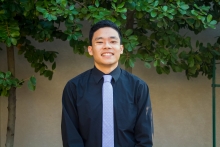 |
Major: Biological Sciences
Home City: Paramount, CA
Contact: cvalencia23@ucmerced.edu
Faculty Mentor: Professor Anna Beaudin
|
Clint Valencia is a fourth year Biology major with an emphasis in Developmental Biology. He is a part of several organizations on campus, such as Alpha Phi Omega and Who We Play For. Being a part of these organizations has taught him how to be a leader and how to take advantage of the opportunities given to him. Clint aspires to work in the medical field in the future and will take his experiences in his undergraduate years to pursue higher education. Some hobbies that he likes to do is traveling and going on food adventures.
Determining IL-7 Expression During Fetal Macrophage Development
Clint Valencia and Anna E. Beaudin, PhD; Molecular and Cell Biology, University of California, Merced
IL-7 is a cytokine responsible for the proliferation and survival of lymphocytes, including T cells. IL-7 signals through a receptor that has two subunits, a common chain and a unique IL-7R chain. While the role of IL-7 signaling in promoting the lymphoid lineage is well-established, little is known regarding the role of IL-7 signaling in myeloid cell development. Our lab has recently shown dynamic expression of IL-7R during fetal tissue resident macrophage development. To gain additional insight into the role of IL-7R signaling in tissue resident macrophage development, we aim to define fetal IL-7 expression in relation to the expression of IL-7R expressing macrophages. We hypothesize that macrophages expressing IL-7R will associate with or migrate towards cells expressing IL-7. To test this, we will perform immunofluorescent staining on cryosections of embryonic day (E) 14.5 transgenic embryos expressing green fluorescent protein (GFP) off the IL-7 locus and the red fluorescent protein Tomato as a marker of IL-7R expression history. Macrophages will be specifically labeled with an F4/80 primary antibody, an established surface marker of macrophages. We will then image whole embryo cryosections to define the temporal-spatial relationship between IL-7R expressing macrophages and IL- 7expressing fetal cells. Results of these experiments will determine which cells express IL-7 during fetal development and will therefore shed light on the dynamics of IL-7 signaling in fetal macrophage development.
Christopher Villanueva
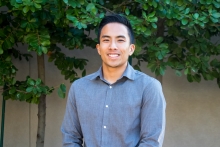 |
Major: Computer Science and Engineering
Home City: Vellejo, CA
Contact: cvillanueva6@ucmerced.edu
Faculty Mentor: Professor Shawn Newsam
|
Chris Villanueva is a rising fourth year undergraduate student who is expected to graduate this spring of 2018 with a BS in Computer Science and Engineering. Chris believes success is achieved by three things: staying involved, always improving, and expanding your network. With this in mind, Chris has held and is currently holding officer positions in his fraternities, Kappa Sigma and Alpha Kappa Psi, as well as become the student supervisor for one of the university's IT departments. With the end of his undergraduate career coming quick, Chris aims to use this year to prepare himself for future success in a graduate program, and use his skills and experiences to apply computer science in ways that will change and benefit society. Aside from that, you can definitely find Chris at music festivals, sporting events, or simply exploring the places (or food) around him!
Estimating Air Pollutant (PM2.5) Levels Using Gradient and Color Information on Landscape Images
Christopher Villanueva and Shawn Newsman, PhD; School of Engineering, University of California, Merced
Air quality control and awareness presides as an important issue in today’s industrialized society. Standardized metrics of air quality measures include PM10 and PM2.5, which are the concentrations of particles smaller than 10n and 2.5n in diameter respectively. In many parts of the world, equipment to measure air pollutants is not readily available, and so other methods are needed. In this project, we investigate the potential of using image processing techniques in order to estimate average local PM2.5 levels. We approach this problem using three techniques: 1) Calculating contrast in the horizon using gradient measurements, 2) Analyzing details of distant mountain details using edge detection, and 3) Measuring color frequencies in regions of the sky. Air contaminated by pollutants (PM2.5) will obscure the visibility and alter the color appearance of the sky in these images. This allows the mentioned methods to give us insight into these characteristics of the images and ultimately estimate PM2.5 levels. Experimental results show us that there is an inverse correlation between image visibility, color, and PM2.5 levels when analyzed at specific time periods and threshold parameters. Solar position and weather conditions are still to be addressed in order to present accurate estimates at diverse times and locations.
Michael Viray
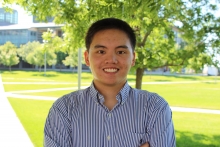 |
Major: Biological Scienes
Home City: Union City, CA
Contact: mviray@ucmerced.edu
Faculty Mentor: Rudy Ortiz
|
Michael Viray is a third year student from Union City, CA. Expected to graduate in Spring 2019 with a BS in Biology and aspires to become a physician. However, Michael's 5 years of volunteering in the Verterans Affairs Clinic made him realize that there are a huge number of ways to be involved in medicine. This experience made him open medical professions. Michael recently was a recipient of the John Elia Veterans Scholarship award, which demonstrates that he was able to become a full time student while maintaining a GPA above 3.0. In his free time, Michael plays the clarinet and is a current member of the UC Merced Bobcat Band.
Effects of Almond Consumption for Eight Weeks on Blood Glucose Control in College Freshmen
Michael Viray, Jaapna Dhillon, PhD, Syed A. Asghar, Quintin Kuse, Natalie De La Cruz, Emily Vu, and Rudy M. Ortiz, PhD; Molecular and Cellular Biology, University of California, Merced
Daily consumption of almonds has many health benefits. Individuals that consume almonds on a daily basis may reduce their risk for metabolic syndrome or some aspects of metabolic disorders. Daily snacking of almonds may also improve cognitive function outcomes such as memory retention. Despite these recent discoveries, many potential health revelations remain elusive. An almond study was performed to further assess the potential benefits of almond snacking on the regulation of blood glucose. First-year university students (n=73, mean age:, mean BMI:) participated in an 8 week intervention (n = 35 control snack vs. n =38 almond snack). Graham crackers served as the isocaloric (325 kcal/d) control snack. Dietary recalls were obtained weekly, and blood samples were taken at the beginning (T0) and weeks 4 and 8 of the study to assess blood glucose and insulin concentrations. HOMA-IR, an index of insulin resistance will be calculated from blood glucose and insulin concentrations. Robust analyses of primary and secondary outcomes remain to be performed. It is expected that daily almond snacking by college freshman will improve glucose tolerance despite the lack of robust changes in body mass or adiposity suggesting that improvements in metabolism can be achieved independent of other commonly evaluated metrics of health, which is especially important in millennials that are nutritionally independent.
Tristan Yang
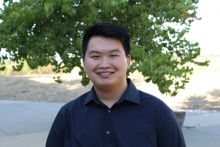 |
Major: Biological Sciences
Home City: Atwater, CA
Contact: tyang39@ucmerced.edu
Faculty Mentor: Professor Aminesh Ray
|
Tristan is a fourth year undergraduate student from Atwater, CA majoring in Human Biology. Tristan has a strong passion for science and his community. He is currently conducting research at Keck Graduate Institute about the genetics behind the interactions between C. elegans and bacteria. Tristan serves as the president of the Quantitative Project at UC Merced, where he collaborates with other members on interdisciplinary research projects. Tristan has a strong passion to give back to his home community, the Central Valley. He has collaborated with many groups, such as Tech Equation and BIOTAQ, hoping to help promote STEM in the valley. Tristan aspires to be a physician scientist and to one day inspire students from underrepresented groups to pursue higher education.
Alexis Zamudio Torres
AlexisZamudio-Torres is a rising third year undergraduate student form Sonoma, CA. For those who do not know of Sonoma, it is also known as wine country. He is expected to graduate in Spring 2019 with a B.S. in Biological Sciences with an emphasis in Human Biology. Alexis was a Resident Assistant the previous acaademic year and will continue to be for the upcoming academic year. Alexis is also a first-generation college student who is part of the Fiat Lux Scholars program. On his own time, Alexis enjoys playing soccer and going on random trips on the weekends with friends. After receiving his Bachelor's degree, Alexis plans to attend graduate school to reach his long-term career goal of becoming a physcial therapist. With his passion for sports, he desires to work with athletes as a physical therapist.




